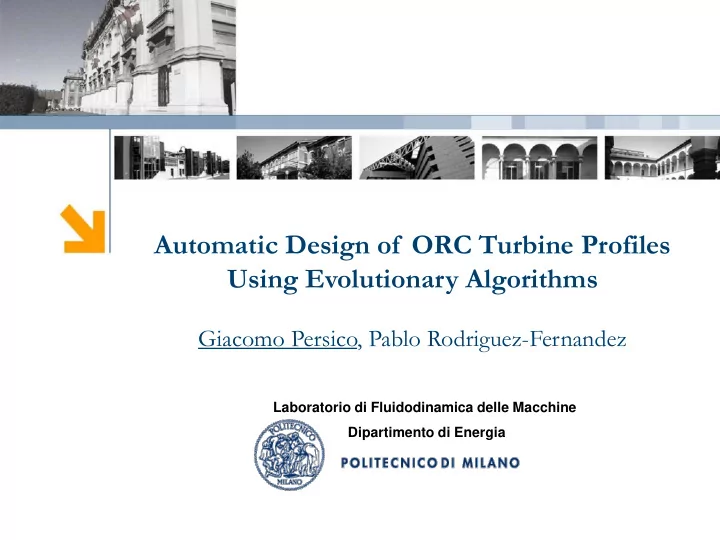

Automatic Design of ORC Turbine Profiles Using Evolutionary Algorithms Giacomo Persico, Pablo Rodriguez-Fernandez Laboratorio di Fluidodinamica delle Macchine Dipartimento di Energia
Design of ORC turbines Turbomachinery design demands systematic procedures ORCs push towards non-conventional turbomachinery (load, efficiency, compactness) Semi-empirical criteria lack of reliability in non-conventional contexts High-fidelity CFD crucial in non-conventional turbomachinery R&D Automatic CFD-based design package required Evolutionary design strategy coupled with: geometric parametrization methods experimentally validated CFD model surrogate models Persico, Rodriguez-Fernandez Automatic Design of ORC Turbine Profiles
Outline • Evolutionary Shape Optimization • Bricks Parametrization model CFD model Surrogate model • Optimization Strategy Layouts • Exercise of Design • Robust Design • Conclusions Persico, Rodriguez-Fernandez Automatic Design of ORC Turbine Profiles
Evolutionary Shape Optimization • Shape Optimization : to minimize an OF using geometry as design parameters • Stochastic Evolutionary Optimization (inspired by Evolution Theory): Direct: no need of problem inversion, only need direct CFD tools Heuristic: requires statistical relevance ( high cost) • Combined with surrogate models to tackle computational cost • Non-dominated Sorting Genetic Algorithm : GA SCHEMATIC 200 generation Genotype 70% of crossover Population Phenotype 2% of mutation elitism Selection criteria Surviving Persico, Rodriguez-Fernandez Automatic Design of ORC Turbine Profiles
Briks Blade geometry parametrization • Concept: blade geometry as succession of regular lines identified by Control Points B-Spline cubic lines: C 2 smoothness, identified by 4 CPs, computed recursively • • Degrees of freedom : impose passing by CPs, circular TE Persico, Rodriguez-Fernandez Automatic Design of ORC Turbine Profiles
Briks CFD model • High-fidelity blade-to-blade flow model • Quasi-3D steady flow model • Hexahedral grids with 50 ÷ 400 kcells • Solver: Finite Volume ANSYS-CFX, with: . HR methods for inviscid fluxes . centred scheme for diffusive terms Turbulence model: k- ω SST with near-wall boundary layer solution (wall y + ~ 0.1) • • Real gas model implemented via Look-Up-Table approach; LuT constructed using a generalized thermodynamic library • Flow model validated against experiments ( Persico et al., 2012, ASME J. Turbomach. ) Persico, Rodriguez-Fernandez Automatic Design of ORC Turbine Profiles
Briks Surrogate model 10 4 OF evaluations required by GA, CFD runs are expensive • surrogate models to speed-up convergence • Surrogate: analytical function that mimics the ‘response surface’, being: highly flexible initially tunable adjustable via a learning process • Re-tuning of the surrogate model Initial interpolation on a data-base (DOE) GA only applied to the interpolated surrogate model Improvement of data-base and re-interpolation close to the optimum • Kriging surrogate model used (suitable for highly irregular data distributions): Persico, Rodriguez-Fernandez Automatic Design of ORC Turbine Profiles
Optimization Strategy: Local vs Global Initial CFD-based DOE for response sampling Surrogate function interpolated and minimized Local ‘trust region’ method Global ‘training’ method Trust region reliability checked by trust ratio Optimum checked by CFD New CFD value added to data-base Surrogate re-interpolated … If reliable ( ρ k > 0.5), trust region shink Surrogate minimum approaches optimum CFD-based DOE in new trust region … Trust region collapses on optimum Persico, Rodriguez-Fernandez Automatic Design of ORC Turbine Profiles
Exercise of Design Test case Supersonic converging-diverging cascade (M = 2.1) for axial ORC turbine (MDM) Baseline configuration: Strong shocks generated on Suction Side and on TE (fishtail) Weaving wake trace due to huge circumferential pressure gradients dramatic raise of loss due to shock mixing downstream (and impact on rotor?) Persico, Rodriguez-Fernandez Automatic Design of ORC Turbine Profiles
Exercise of Design Procedure Objective Function Standard deviation of static pressure half a chord downstream of the TE Minimize shock, shock mixing loss, flow disuniformity in stator-rotor gap Design Space Parametric study on CP number and design space initially performed 15 movable CPs in the rear blade section both on PS and SS Computational Cost grid dependence analysis to reduce the cost of CFD run low fidelity (100 kc) optimization, high fidelity (400 kc) validation Persico, Rodriguez-Fernandez Automatic Design of ORC Turbine Profiles
Exercise of Design Convergence history Local Global Convergence attained by both methods nearly identical min OF (and blade!) Global- Cost ≈ 20 h (16 proc. Cluster); Local-Cost ≈ 3 × Global-Cost LF optimization proved to be reliable when verified in HF (very well matched trend) Persico, Rodriguez-Fernandez Automatic Design of ORC Turbine Profiles
Optimization Results Outcome Nearly uniform Pressure downstream Optimized configuration Enhanced divergence Dramatic shock reduction Persico, Rodriguez-Fernandez Automatic Design of ORC Turbine Profiles
Optimization Results Flow field and performance Baseline Optimized Persico, Rodriguez-Fernandez Automatic Design of ORC Turbine Profiles
Constrained Optimization 1% of flow rate Convergence history Surrogate model constructed also for the contrained quantity Convergence attained but outcome slightly worst than non-constrained optimization Non-constrained optimal blade satisfies flow rate contraint by fixed CPs up to throat Geometrical contraint more effective than process contraint (chocked flow) Persico, Rodriguez-Fernandez Automatic Design of ORC Turbine Profiles
Robust Design Multi-point Objective Function: Standard deviation of P combining 2 or 3 operating conditions (possibly weighted) Baseline Optimized worst scenario ( β = 0.5 β DES ) β -loss curves (off-design) Persico, Rodriguez-Fernandez Automatic Design of ORC Turbine Profiles
Outcome of Evolutionary Optimization similar to Outcome of Adjoint-based Gradient Optimization Pini, Persico et al. , Adjoint Method for Shape Optimization in Real-Gas Flow Applications, J. Eng. Gas Turbines Power, 2015, Vol 137 Persico, Rodriguez-Fernandez Automatic Design of ORC Turbine Profiles
Conclusions • High-fidelity methodology for ORC turbine design developed and applied • Package: genetic algorithm, surrogate model, CFD, geometry parametrization • Two surrogate-based strategies tested and proved to provide similar outcome • Successful optimization (40% loss reduction), with 20 h of computational cost • Constrained optimization developed, even though preventing full minimization • Successful implementation for robust (i.e., multi-point) design Persico, Rodriguez-Fernandez Automatic Design of ORC Turbine Profiles
Thank you! Any questions? giacomo.persico@polimi.it www.lfm.polimi.it Laboratorio di Fluidodinamica delle Macchine Dipartimento di Energia Persico, Rodriguez-Fernandez Automatic Design of ORC Turbine Profiles
Recommend
More recommend